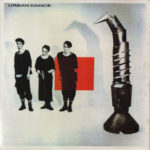
Even for Haruomi Hosono, Urban Dance is a rare bird. Let me step back. After listening to Friends of Earth and Love, Peace, and Trance I may be incorrect. Urban Dance’s self-titled debut is a rare bird for Japanese electronic music. Produced by Haruomi Hosono, Urban Dance was the rare slice of Japanese music that drew inspiration from a harder edge sound: EBM (electro body music).

Urban Dance were a trio led by Shinobu Narita of influential Japanese minimal wave act 4-D, Kengo Koyama who would later play a brilliant role as bass player for Hiroki Okano’s early haunting electronic ambient music, and Koichi Matsumoto who would later set off into the remix artist world. Joining them along for the ride was Haruomi Hosono as producer. What clues you into the off-kilter sound heard in Urban Dance might just be the record label this album was released under.
Released on the Non-Standard label, 1985’s Urban Dance joined Harry’s playground label for fascinating genre experiments. Under his own name and FOE, Harry would use Non-Standard to release electro workouts that hinted at a growing personal interest in urban American dance music. Working with French group Mikado or Miharu Koshi, Harry was able to try his hand at leftfield, Italian disco and Gallic pop. The release of Pizzicato V’s indie J-Pop simply being another cherry on top of Harry’s wandering tastes. What was different about Urban Dance was how much harder it repped the house sound, compared to the rest of the label. This was music influenced by the second-wave of electronic dance music.
Urban Dance was arranged like a particularly raw Afrika Bambaataa record. Haruomi Hosono appearing to be pushed by the trio assume the role of Arthur Baker, dedicating himself to booming every drum and bass with as much force as possible. Drawing direct lines from the music of Die Krupps or D.A.F. into places where it could slot into the new, Japanese music, Urban Dance tried to prove that this generation/could could get heavy, in this way. Largely sample and drum machine driven, the opener “Why” and A-side cut “Ceramic Love” propels you directly into the thick of this sound.
Aiming for the booty rather than the earspace, Urban Dance still works as killer dancefloor material. Rather than stick with pure EBM, Urban Dance wisely rolls in dancehall, exotica, and even early house music. “Subete Wa Himitsu No Yoru” and “Dreamer” serve as brilliant sojourns to hazier places that tweak the EBM formula into not so obvious ways. By the time you get to their wicked reimagining of Haruomi Hosono’s “Non-Standard Music” from S-F-X one can appreciate their transformation of that track from heady synth funk to even headier electro dance music. Haruomi wanted them to go hard and in Urban Dance they made sure not to hold anything back.
Still fresh after all these years, Urban Dance deserves better than its forgotten place in Hosono history.
